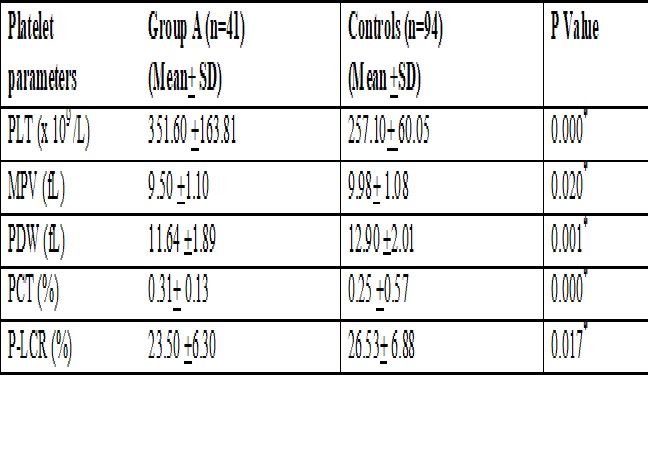Study of platelet parameters in bacterial infections of lower respiratory tract
Abstract
Background: Respiratory tract infections are one of the commonest bacterial infections. Platelets play an important role in inflammatory response against infectious agents. Bacterial components activate platelets to release inflammatory mediators. The changes platelets undergo during their activation are reflected in the platelet parameters. This study aims to evaluate platelet parameters in the lower respiratory tract infections.
Materials & methods: Cross-sectional study on sputum culture proven bacterial infections of the lower respiratory tract was done for three months. Platelet parameters of 94 cases were compared with 94 healthy controls. Cases were sub grouped as group A (with leucocytosis) and group B (without leukocytosis). Comparative analysis of platelet parameters between these subgroups and controls was done. P value was calculated and <0.05 was considered significant.
Results: Platelet count (p <0.05) and plateletcrit were higher, Mean platelet volume (p <0.05), Platelet distribution width (p <0.001) and Platelet large cell ratio were lower in cases compared to controls. Group A showed significantly higher PLT (p < 0.05) and PCT (p <0.001) than group B whereas the difference in other parameters was not significant. All platelet parameters were significantly altered in patients with leukocytosis on comparison with controls whereas only MPV, PDW and P-LCR showed significant change in patients without leukocytosis when compared with controls.
Conclusion: Platelet parameters show variation in the lower respiratory tract infections. As they can be determined as a part of routine complete blood picture analysis, they may be considered as markers of inflammation in the diagnosis of lower respiratory tract infections.
Downloads
References
2. Krauel K , Weber C, Brandt S. et al. Platelet factor 4 binding to lipid A of Gram-negative bacteria exposes PF4/heparin-like epitopes. doi: 10.1182/blood-2012-06-434985. Epub 2012 Aug 31. [pubmed]
3. Yang D , Chen Q, Hoover DM, et al. Many chemokines including CCL20/MIP-3alpha display antimicrobial activity. J Leukoc Biol. 2003 Sep;74(3):448-55. [pubmed]
4. Yeaman MR . Platelets in defense against bacterial pathogens. doi: 10.1007/s00018-009-0210-4. Epub 2009 Dec 15.[pubmed]
5. Klinger MH , Jelkmann W. Role of blood platelets in infection and inflammation. DOI:10.1089/10799900260286623. [pubmed]
6. Para RA, Fomda BA , Jan RA , et al. Microbial etiology in hospitalized North Indian adults with community-acquired pneumonia. DOI:10.4103/lungindia.lungindia_288_17. [pubmed]
7. Sahin F, Yazar E, Yildiz P. Prominent features of platelet count, plateletcrit, mean platelet volume and platelet distribution width in pulmonary tuberculosis. Multidiscip Respir Med. 2012;7(1):38. doi: 10.1186/2049-6958-7-38. Google/Pubmed
8. Karadag-Oncel E , Ozsurekci Y, Kara A, et al. The value of mean platelet volume in the determination of community acquired pneumonia in children. DOI:10.1186/1824-7288-39-16
9. Unsal E , Aksaray S, Köksal D, Sipit T. Potential role of interleukin 6 in reactive thrombocytosis and acute phase response in pulmonary tuberculosis. DOI: 10.1136/pgmj.2004.030544. [pubmed]
10. Zareifar S , Farahmand Far MR, Golfeshan F, Cohan N. Changes in platelet count and mean platelet volume during infectious and inflammatory disease and their correlation with ESR and CRP. DOI:10.1002/jcla.21673. [pubmed]
11. Tozkoparan E , Deniz O, Ucar E, et al. Changes in platelet count and indices in pulmonary tuberculosis. DOI:10.1515/CCLM.2007.194. [pubmed]
12. Afyon M, Artuk C. Could Mean Platelet Volume be a useful marker for infectious diseases? A review of literature. Med SCi.2016;5(4):1059-62. doi: 10.5455/medscience.2016.05.8460. Google
13. Bath PM, Butterworth RJ. Platelet size: measurement, physiology and vascular disease. Blood Coagul Fibrinolysis 1996;7(2):157-61. Google/Pubmed. [pubmed]
14. Viswanathan S, Saravanakumari V. Are platelet indices useful in diagnosis if tropical acute febrile illnesses? Journal of Local and Global Health Science. 2016:3. doi: 10.5339/jlghs.2016.3. Google
15. Ladhani S, Lowe B, Cole AO, Kowuondo K, Newton CR. Changes in white blood cells and platelets in children with falciparum malaria: relationship to disease outcome. Br J Haematol 2002;119(3):839-47. doi: 10.1046/j.1365-2141.2002.03904.x. Google/Pubmed. [pubmed]
16. Cho SY, Jeon YL, Kim W, et al. Mean platelet volume and mean platelet volume/platelet count ratio in infective endocarditis. DOI: 10.3109/09537104.2013.857394. [pubmed]
17. Tekin M1, Konca C, Gulyuz A, et al. Is the mean platelet volume a predictive marker for the diagnosis of acute pyelonephritis in children? DOI:10.1007/s10157-014-1049-z. [pubmed]
18. Babu E, Basu D. Platelet large cell ratio in the differential diagnosis of abnormal platelet counts. Indian J Pathol Microbiol.2005;47(2):202-5. [pubmed]
19. Yalavarti S, Halder NR, Pagidikalava A. Utility of Platelet Indices in diagnosing the underlying cause of thrombocytopenia due to accelerated platelet destruction. Annals of pathology and laboratory medicine. 2018;5(4):296-300. doi: 10.21276/APALM.1717. Google
20. Santimone I, Di Castelnuovo A, De Curtis A, et al. White blood cell count, sex and age are major determinants of heterogeneity of platelet indices in an adult general population: results from the MOLI-SANI project. DOI: 10.3324/haematol.2011.043042. [pubmed]
21.Ozturk N, Baygutalp NK, Bakan E, Altas GF, Polat H, Dorman E. Changes in platelet parameters in leukocytosis. Pan African Medical Journal. 2016;24:185. doi: 10.11604/pamj.2016.24.185.7510. Google/Pubmed



 OAI - Open Archives Initiative
OAI - Open Archives Initiative


